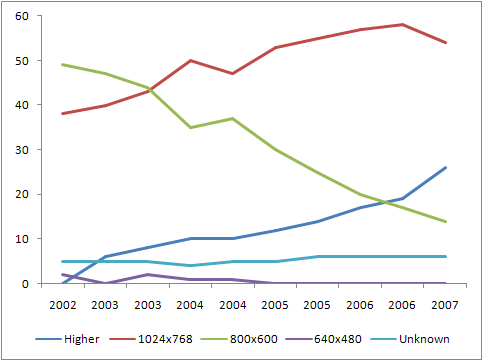Screen resolution. Thinking out loud
 I recently looked at the global statistics of screen resolutions and was surprised. Back in January 2007, the number of users with a screen resolution of 800x600 fluctuated at around 15-17 percent , and at the moment only 6 - 9 percent.
I recently looked at the global statistics of screen resolutions and was surprised. Back in January 2007, the number of users with a screen resolution of 800x600 fluctuated at around 15-17 percent , and at the moment only 6 - 9 percent."- But this is something that says yes " - I thought, and began to estimate the calculations in my mind. If in less than six months the number of people with a small ... uh ... screen has decreased by 10 percent, then by the end of the year they will almost disappear! (Screens, not people :))
And by itself, the figure of 6-7 percent is already insignificant. Approximately the same number of users do not use Javascript .

Then I decided to take a look at which of the well-known sites supports 800x600. There is such a picture (the choice is absolutely arbitrary):
- yahoo.com - no
- yandex.ru - no
- mail.ru - yes (!)
- microsoft.com - no
- apple.com - no
- youtube.com - no
- rambler.ru - yes (!)
- digg.com - no
You can certainly continue, but the general trend is clear in my opinion.
Only Rambler and Mail.Ru were surprised, he expected the least from them, but come and go.
Of course, you can say that this is supposedly giants, and they can afford it, but it seems to me that this is not so. They just made a sensible calculation.
Already, the audience with a screen resolution higher than 1024x768 is at least four times larger than the audience with a resolution of 800x600 and the gap will only widen. So who is more profitable and more promising to support?
Of course there are many "but." We can say that those with a higher screen resolution will still see the site optimized for 800x600, but who wants to see a small box in the center of a large monitor?
We can say that we should move to the "rubber" layout. I agree, but unfortunately not every design can be implemented in this way.
You can determine the screen resolution and slip the CSS depending on it. But this is a problem. Not every designer will do 2 or 3 layouts, and not always it will be appropriate. Work doubles, and returns tend to zero. And with good acceleration.
And according to this, I had an obvious thought that it was time to stop focusing on 800x600 pixels and go up a level. But with a reservation.
Let us proceed from the fact that we need a maximum of visitors. When developing a site, it is necessary to make a layout for resolution 1024x768, but important information / blocks should be placed in a “cube” with dimensions of 800x600 (760x430), starting from the upper left corner of the window.

The result is that the sheep are intact and the wolves are fed. All important information can be seen at any extension, without using horizontal scrolling.
This is of course only a partial solution, but it seems to me that every month it will be all the more relevant.
The only qualification of my mini-analysis is that Runet statistics are limited by Spaylog and Liveinternet from memory.
It is interesting to listen to your opinion on this issue, habralyudi.
')
Source: https://habr.com/ru/post/9313/
All Articles